Fujifilm X-Pro1 Review
Fujifilm X-Pro1
Could this be the best compact system camera on the market?
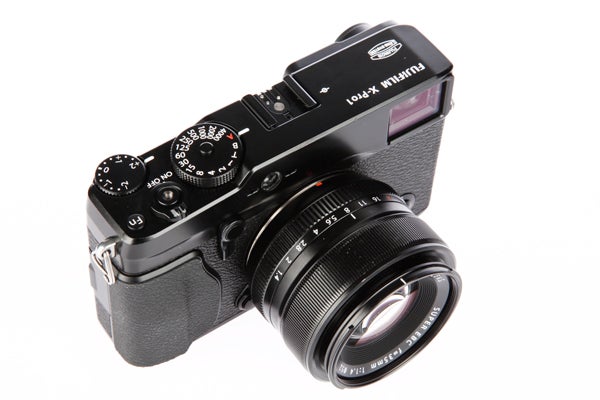
Verdict
Pros
- Outstanding image quality
- Class-leading high ISO performance
- Old-school manual controls
- Super-sharp LCD screen
Cons
- Doesn't come cheap
Key Specifications
- Review Price: £1329.99
- 16.3MP X-Trans APS-C CMOS sensor
- Fuji Processor Pro image processor
- ISO 200 - 6400 (exp. to 100 - 25,600)
- 3in, 1.44m-dot LCD monitor
- 1080/24p Full HD movie recording
The X-Pro1 is built around an all-new 16.3-megapixel ‘X-Trans’ APS-C CMOS sensor. The big deal here is that the sensor breaks with the standard 2×2 Bayer colour filter array and instead uses its own bespoke 6×6 pixel arrangement. This has allowed Fuji to remove the anti-aliasing filter (also referred to as the low-pass filter), which in turn leads to increased edge sharpness in images (the low-pass filter is essentially a light softening filter), but without the moiré problems that can often dog cameras lacking a low-pass filter. It’s a smart idea in theory and the good news is that it works in practice too. We’ll talk about image quality in more depth on the next page, but for now we’ll put it straight out there that the X-Pro1 and the dedicated 35mm f/2.8 Fujinon EF lens we tested it with is one of the sharpest combinations we’ve yet seen – sharper than many high-end DSLRs even.
Returning to the X-Pro1’s internal specs, the new X-Trans sensor is backed up by Fuji’s powerful EXR Processor Pro image processor that enables the capture of Full HD movie recording at 24fps, as well as delivering low-noise images even at higher ISO settings. The X-Pro1 offers a standard range of between ISO 200 and 6400, which can be extended from ISO 100 – 25,600. Naturally enough the X-Pro1 is able to record loss less Raw image files (Fuji .RAF format) as well as JPEGs.
Maximum output at full resolution in the default 3:2 aspect is 4,896 x 3,264 pixels, although there are also options to lower resolution to 8MP and 4MP. Alternatively, you can also choose to shoot in 16:9 and 1:1 aspects, although as these basically just take a crop from the 3:2 sensor they come in at slightly lower resolutions. There’s no 4:3 option through.
The X-Pro1 benefits from the same clever hybrid viewfinder tech used on the X100, whereby a lever on the front of the camera toggles between an optical view overlaid with a translucent framing box, and a 1.44million-dot EVF that offers a 100% field of view. Both have their own particular benefits and, overall, it’s a really neat system to use. We also like how the viewfinder displays all of the primary shooting settings – shutter speed, f-stop, ISO and the all-important light meter (more on this in a moment) along the bottom and side of the frame in both optical and EVF modes.
Should you wish to frame your shots using the rear LCD monitor, then the good news is that the 3in, 1.44m-dot screen provides a class-leading degree of clarity. Not only is this useful for framing, it also enables you to easily zoom in and check image sharpness when deciding which shots are ‘keepers’ in Playback mode. A View Mode button under the hotshoe allows you choose between the optical viewfinder/EVF and the LCD monitor. Alternatively, you can make use of the built-in eye sensor to seamlessly switch between the two.
In keeping with the X100, the X-Pro1 doesn’t offer a dedicated exposure mode dial, nor the standard range of exposure modes usually found one, but rather apes a retro 35mm film camera with a dedicated shutter speed dial and an aperture ring on the lens. There’s an Automatic setting on both of these should you wish to let the camera do the work (effectively putting the camera into Aperture-priority or Shutter-priority exposure mode), but should you want to use the camera in fully manual mode it’s simply a case of selecting the aperture or shutter speed you want and then using the light meter that runs down the side of the LCD screen/optical viewfinder/EVF to adjust the other as necessary. 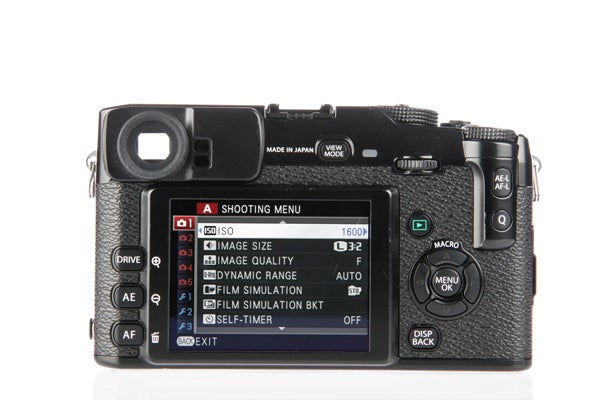
It has to be said that shooting fully manual in this way this way feels wonderfully intuitive not to mention decidedly old-school, however it does make the shooting process slightly more time consuming, at least until you get used to it. That said, the metal shutter speed dial and lens-based aperture ring undoubtedly make for a far more satisfying user-experience than simply rotating a thumb wheel.
In addition to its still image capabilities, the X-Pro1 can also record Full HD movies at 24fps with stereo sound, although there’s no external microphone jack. Given that there’s no main exposure model dial you need to open up the Drive sub-menu and scroll down to get into movie recording mode. Besides the microphone input the X-Pro1’s only other major omission is a built-in flash, although it does sport a hotshoe.
As an all-new CSC standard, the X-Pro1 becomes the first camera to use the Fuji ‘X’ lens mount, and as such launches alongside a set of three premium-grade Fujinon XF lenses that have been especially designed to take advantage of the bespoke sensor design and lack of low-pass filter. These include an 18mm f/2, a 35mm f/1.4 (as supplied on our review sample) and a 60mm f/2.4 Macro. Of course, given the X-Pro1’s APS-C sensor the usual 1.5x crop factor should be applied to the XF focal lengths in order to calculate their 35mm equivalent.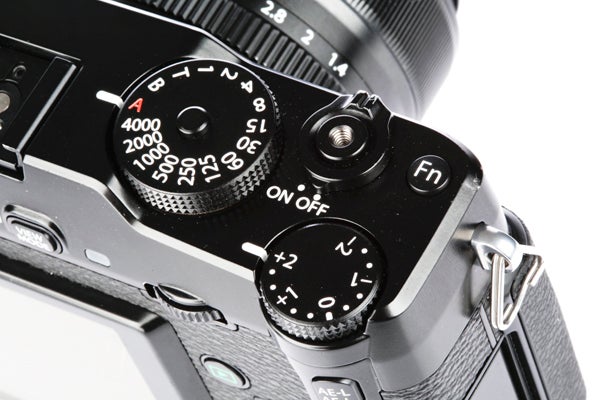
Picking the Fujifilm X-Pro1 up for the first time the first thing that strikes you about it is the size; by no means is it a small camera. Indeed, compared to its immediate APS-C touting compact system rivals such as the Samsung NX200 or Sony NEX-7, the X-Pro1 is by far the biggest of the bunch. If you’re planning on going out all day with it then You’ll almost certainly need a camera bag to carry it around as it’s too big for all but the largest of coat pockets. The bag itself needn’t be all that huge though.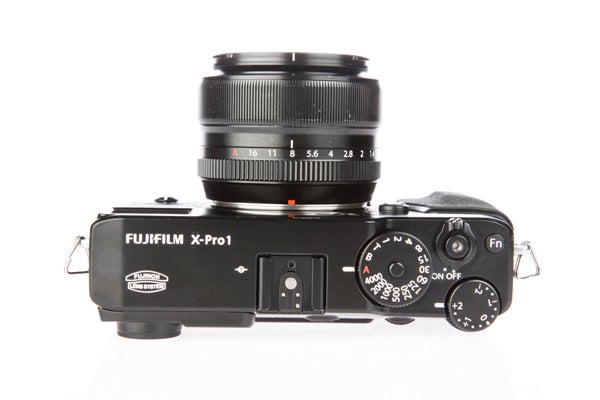
Despite the bulk and the not inconsiderable weight that comes with it, the X-Pro1 really does feel like a premium camera. Build quality is superb, with an all-metal outer casing finished off with solid metal Shutter speed and EV compensation dials. The camera’s unashamedly retro design is further enhanced by the faux leather finish used on other X-Series models – and indeed just about any 35mm film camera from the 1960s onwards. Taking this retro theme even further is the internally threaded shutter button that allows you to attach a threaded shutter-release cable.
On the front there’s a low-profile rubberised moulded finger grip that actually offers far more purchase than it looks to have any right to. Indeed, we found that it enabled us to get quite a comfortable hold of the camera. One-handed operation is just about possible, although you’re undoubtedly better off using two hands – especially given that the X-Pro1 lacks any built-in image stabilisation.
Start-up is all but instantaneous, with the X-Pro1 going from being switched off to focused and ready-to-shoot in a fraction under two seconds which is pretty impressive even for a CSC. Continuous shooting, meanwhile tops out at a respectable 6fps with the camera able to record around 12 consecutive full-res JPEGs before the buffer fills and the camera begins to slow down. Switching over to Raw capture brings this figure down to around 8-10 depending on the complexity of the scene.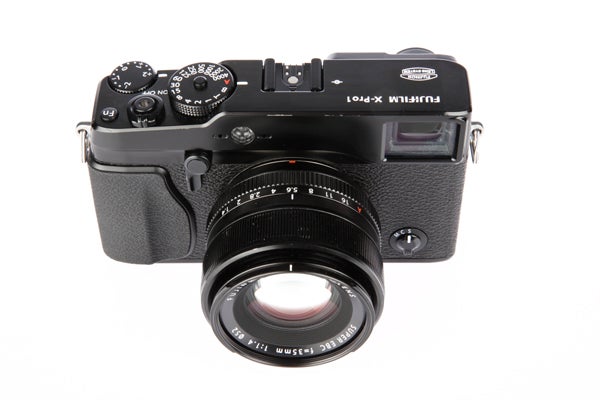
Autofocus is taken care of via a 49-point module that covers the vast majority of the viewfinder, with only a small patch on the extreme edges that’s not covered. The focus box can be assigned to any of these points which allows for all kinds of creative focusing possibilities – especially with the f/1.4 lens attached. Autofocus speed itself isn’t at all bad, although it’s not as fast as some other compact system cameras we’ve tested recently. There’s no AF tracking mode either, although we’re not going to hold that against the X-Pro1 too much as it isn’t really designed to be a speed-driven camera for capturing fast action with in the first place.
At present there are only three Fujinon XF lenses available for the X-Pro1’s bespoke X-mount, all of which are primes. Our review sample came with a super-fast 35mm f/1.4 optic which we found to be exceptionally sharp as well as bags of fun thanks to the exceptionally shallow depth of field effect it’s capable of producing. Put simply, it’s the kind of lens you can shoot portraits with in which the subject’s eyes are pin sharp while the back of the ears are blurred.
Of course, the lack of dedicated XF lenses along with the fact that they are all primes does mean that the choice of focal lengths available to the X-Pro1 is presently a bit limited. No doubt Fuji will add to the range though and hopefully bring some XF zoom lenses to the table as well. If Fuji can maintain the same high degree of quality with all its XF optics that we’ve seen with the 35mm f/1.4 then they’ll doubtless be worth the wait.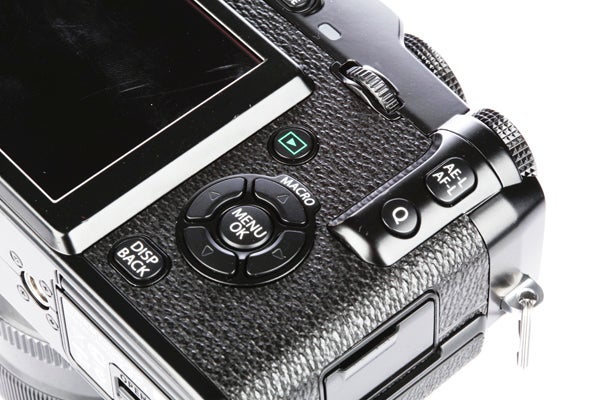
And so to what is undoubtedly the X-Pro1’s trump card: image quality. Put simply, overall image quality is some of the best we’ve ever seen an APS-C camera. The bespoke X-Trans sensor, EXR Processor Pro and Fujinon XF lens all combine to produce JPEGs that are breathtakingly sharp and supremely detailed straight out of camera. Even when viewed at 100% images maintain sharp edges, and reveal stunning amounts of fine detail. Those looking for a camera to regularly make poster-sized prints with will find the X-Pro1 fits the bill nicely.
As with most advanced, enthusiast-targeted cameras the X-Pro1 offers plenty of scope to shape the type of images it will produce via a rich array of image processing customisation options. These are found in the main menu and enable you to adjust sharpness, highlight tones, shadow tones, dynamic range and noise reduction among others. Being a Fuji camera, there’s also the option to choose from a range of Film Simulation styles which, as always, are named after (and mimic the look of) classic 35mm Fuji film stock; with Provia offering lifelike colour, Velvia offering something more vibrant and saturated and Astia something deliberately muted. There’s also a good range of bracketing options available – from basic exposure and ISO bracketing to Film Simulation bracketing.
Metering is taken care of via a TTL 256-zone module that proves consistently reliable. Should you need to you can call upon /-2EV exposure compensation via the solid metal dial that’s located within easy reach of the thumb on the top plate. In addition, there’s also a dedicated AE-L/AF-L exposure/focus lock button that can be called upon in trickier lighting conditions. Again, this is found within easy reach of the thumb on the back of the camera. White balance also proves accurate when left in the Automatic position, although you can, of course, force it to the temperature you require.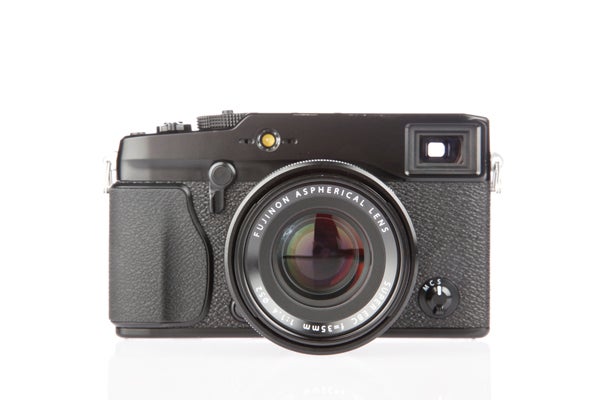
High ISO is another area in which the X-Pro1 offers class-leading performance, especially in the mid to high settings of ISO 1600 and above, where it’s able to produce cleaner, sharper images than most DSLRs. At lower sensitivity settings of ISO 100 to 800 image noise is all but non-existent as might be expected, but nudge things up to ISO 1600 or 3200 and you’ll be hard pressed to spot any significant deterioration. Even the top standard setting of ISO 6400 produces excellent results with very little in the way of visible noise. Beyond this, at the extended settings of 12,800 and 25,600 some noticeable image degradation does occur, however the fact that you can still get useable images from both settings speaks volumes for the overall quality of the X-Pro1. It’s the kind of camera that image quality purists will quickly fall in love with.
Verdict
The Fuji X-Pro1 is an enthusiast-level compact system camera that produces class-leading image quality and a really satisfying user experience thanks to its manually operated shutter speed dial and lens-based aperture controls. Those looking for something to shoot fast-moving action with might want to look elsewhere, but for image quality purists, 35mm SLR film veterans and anyone looking for a camera that’s as rewarding to use as it it is capable of should give the X-Pro1 serious consideration. While it doesn’t come cheap, the X-Pro1 is a serious bit of kit that is sure to reward those who invest in one.

ISO 200

ISO 400

ISO 800

ISO 1600

ISO 3200

ISO 6400

ISO 12,800

ISO 25,600
And, taking the X-Pro1 out of the studio, here are a few examples of what you can expect in a real-world situation:

ISO 1600

ISO 3200

ISO 6400

ISO 12,800

ISO 25,600








Trusted Score
Score in detail
-
Value 7
-
Design & Features 9
-
Image Quality 10
-
Build Quality 10
Features
| Camera type | Mirrorless Camera |
| Megapixels (Megapixel) | 16.3 Megapixel |
| Optical Zoom (Times) | n/ax |
| Image Sensor | X-Trans APS-C CMOS |
| Optical focal length | n/a |
| Shutter speed | 30 - 1/4000 |
| Auto focus | 49-area TTL contrast detection |
| Manual focus | Yes |
| Max output resolution | 4896 x 3264 |
| Other resolutions | 16:9) 4896 x 2760 / (1:1) 3264 x 3264 M : (3:2) 3456 x 2304 / (16:9) 3456 x 1944 / (1:1) 2304 x 2304 S : (3:2) 2496 x 1664 / (16:9) 2496 x 1408 / (1:1) 1664 x 1664 |
| Focus range | n/a |
| Exposure control | Manual, Shutter-priority, Aperture-priority, Automatic |
| Exposure metering | TTL 256-zones metering, Multi / Spot / Average |
| Exposure compensation | -2.0 EV - +2.0 EV, incliment with 1/3 EV step |
| Image Stabilisation | No |
| ISO settings | ISO 200 - 6400 (exp to 100 - 25,600) |
| LCD Monitor | 3in, 1.44m-dot |
| Viewfinder | Hybrid (Optical/EVF) |
| Flash range | No built-in flash |
| Flash modes | n/a |
| White balance modes | Automatic scene recognition Custom, Color temperature selection (K) Preset: Fine, Shade, Fluorescent light (Daylight), Fluorescent light (Warm White), Fluorescent light (Cool White), Incandescent light, underwater |
| Drive modes | Single, Continuous (3/6fps), timer (2/10sec) |
| Image formats | JPEG, Raw (.RAF) |
| Picture adjustments | RAW conversing, Image rotate, Red-eye reduction, Photobook assist, Erase selected frames, image search, Multi-frame playback (with micro thumbnail), Slide show, Mark for upload, Protect, Crop, Resize, Panorama, Favorites |
| Video (max res/format) | 1080/24p Full HD |
| Movie length | 29mins |
| Self timer | 2sec, 10sec |
| Memory card slot | SD, SDHC |
| Supplied memory | None |
| Batteries supplied | Yes, Li-Ion |
| Charger supplied | Yes |
| A/V output | Yes |
| Charging/Computer Connection | Yes |
| HDMI | Yes |
Physical Specifications
| Dimensions Width (Millimeter) | 139.5mm |
| Depth (Millimeter) | 81.8mm |
| Length (Millimeter) | 42.5mm |
| Weight (body only) (Kilogram) | 400kg |

